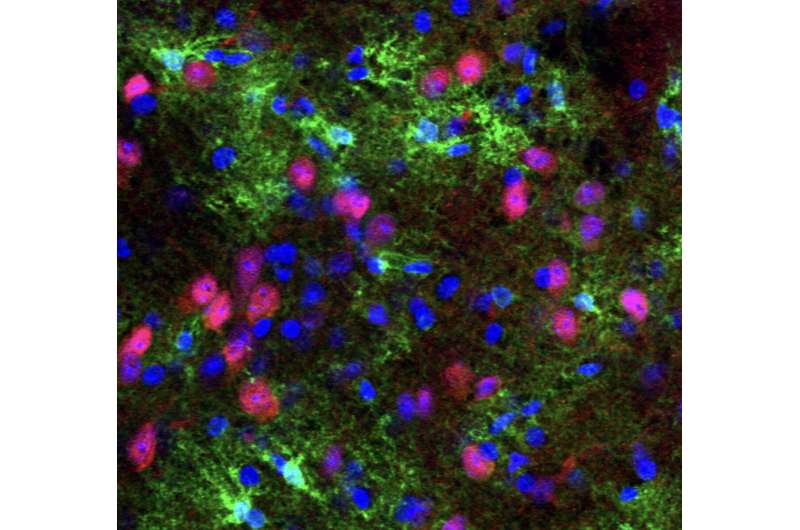Study highlights the role of astrocytes in the synaptic regulation of VTA dopamine neurons

Astrocytes, a sub-population of glial cells with a distinctive star-like shape, are known to play a vital role in numerous neuronal functions, including synaptic support, the regulation of energy metabolism, and the control of blood flow in the brain. While many studies have investigated their functions and associated mechanisms, their contribution to the healthy functioning of the brain is yet to be fully uncovered.
Researchers at the CNR Institute of Neuroscience and the University of Padua, the Italian Institute of Technology (IIT) and the Polytechnic University of Le Marche in Italy have recently carried out a study investigating the so far elusive role of astrocytes in the so-called ventral tegmental area (VTA), a hub of the mesocorticolimbic circuitry that plays fundamental roles in cognition, locomotion, reward, motivation and aversion. Their findings, published in Nature Neuroscience, suggest that astrocytes participate to the synaptic regulation of VTA dopamine neurons.
“Starting from the Nineties, our research primarily explored the role of astrocytic calcium signaling in the brain,” Giorgio Carmignoto, one of the researchers who carried out the study, told MedicalXpress. “In our latest study, we investigated whether astrocytes modulate the activity of dopaminergic neurons in the ventral tegmental area (VTA). The study was inspired by our belief that, in all brain circuits—with no exceptions—astrocytes and neurons, are both fundamental components that through synaptic circuit-specific and reciprocal signaling shape brain network activity in different ways.
“Our paper is the final product of an intense, long-lasting collaboration among four different groups (…. one group that combines different skills). Ezio Bosso (a famous music director that just recently passed away) wrote: ‘There is only one way to do music: together,’ and we can make this sentence our own by saying: ‘There is only one way to do science: together.'”
The key idea behind the research by Carmignoto and his colleagues is that the functioning of the brain relies on a network of highly interacting neurons and astrocytes. In their recent study, they set out to specifically examine the role of astrocytes in the VTA circuitry, which was rarely explored in previous literature.
Past findings suggest that the release of dopamine and endocannabinoids at the level of dopaminergic neuronal dendrites can act on both presynaptic terminals and postsynaptic neurons to modulate activity in the VTA. Carmignoto and his colleagues set out to explore the possibility that these previously reported neuronal signals also recruit astrocytes, which in turn modulate VTA synaptic circuitry.
To do this, they first conducted a series of electrophysiological experiments, where they recorded the activity of dopaminergic neuron pairs in slices of mouse VTA tissue. This allowed them to determine whether the excitatory synaptic transmission onto one of the dopamine neurons in the pairs increased after a burst was fired on the other neuron.
“In brain imaging experiments conducted on astrocytes adjacent to the burst firing dopamine neuron, we then studied whether and how astrocytes respond with calcium elevations to the burst firing induced in the dopamine neuron,” explained Marta Gómez-Gonzalo, another member of the research team.
“In light of the results we obtain, we propose that astrocytes are activated by dopamine and endocannabinoids. Indeed, in collaboration with Fiorenzo Conti’s group, we provide evidence that burst-firing neurons induce recurring calcium elevations in nearby astrocytes through activation of both dopamine type-2 and endocannabinoid type-1 receptors.”
Carmignoto and his colleagues then conducted a series of experiments using an electron microscope, which confirmed that dopamine type-2 and endocannabinoid type-1 receptors were co-expressed in astrocytes. Using pharmacological and genetic techniques, they also demonstrated that the activation of these two receptors in astrocytes, probably followed by the release of glutamate, play a key role in regulating synaptic transmission onto VTA dopaminergic neurons.
Finally, the researchers used chemogenetic tools to selectively activate astrocytes in the VTA of living mice and observe resulting activity in the region. Their observation revealed that astrocytes regulate the burst firing of VTA dopamine neurons and induce hyperlocomotion.
“We identified a hitherto unknown, sex and age-dependent, astrocyte-mediated mechanism of long-term synaptic potentiation of the excitatory transmission onto VTA dopaminergic neurons,” Carmignoto said. “Consistent with the key role that the excitatory transmission exerts on the firing activity of VTA dopaminergic neurons, in collaboration with Annalisa Muntoni in Cagliari and Francesco Papaleo in Genova, we found that in vivo astrocyte activation increases the burst firing of dopamine neurons in the VTA and induces locomotor hyperactivity, a behavior that is known to be associated with increased activity of VTA dopaminergic neurons.
“This is, in our opinion, an important observation, as the burst firing of VTA dopamine neurons is the code used by dopamine neurons to regulate dopamine release at multiple VTA target regions, thereby controlling various behavioral states including reward and aversion, learning, motivation, attention and locomotor activity.”
Overall, the recent work by this team of researchers advances the hypothesis that the reciprocal communication between astrocytes and neurons in the VTA plays a crucial role in the manifestation of dopamine-dependent behaviors. These behaviors are known to be associated with numerous psychiatric conditions, including obsessive-compulsive disorder and drug addiction.
In the future, the findings presented by Carmignoto and his colleagues could thus help to shed more light on the mechanisms underpinning these conditions, as well as other pathologies associated with the dysregulation of the dopaminergic system.
“In our next studies, we plan to investigate whether a dysregulation of the dopaminergic neuron–astrocyte reciprocal communication within the VTA contributes to the development of disease states, including drug-addiction, motivation disorders and psychiatric disorders with a strong motor component, such as attention-deficit/hyperactivity disorder,” Gómez-Gonzalo added.
More information:
Linda Maria Requie et al, Astrocytes mediate long-lasting synaptic regulation of ventral tegmental area dopamine neurons, Nature Neuroscience (2022). DOI: 10.1038/s41593-022-01193-4
Journal information:
Nature Neuroscience
Source: Read Full Article
